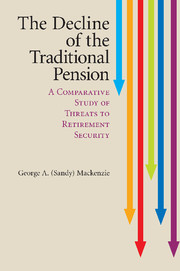Book contents
- Frontmatter
- Contents
- List of Tables
- List of Figures
- List of Boxes
- Acknowledgments
- Introduction
- PART ONE
- 1 The Development of Employer-Provided Pensions
- 2 The Economics of Employer-Provided Pension Plans
- 3 Issues in Funding and Investing
- 4 Current Regulatory Issues
- 5 Public-Sector Employer-Provided Pensions and Recent Innovations in the First Tier
- PART TWO
- Appendix 1 Ten Country Profiles
- Appendix 2 Mathematical Treatments and Derivations
- Glossary
- References
- Index
4 - Current Regulatory Issues
Published online by Cambridge University Press: 05 June 2012
- Frontmatter
- Contents
- List of Tables
- List of Figures
- List of Boxes
- Acknowledgments
- Introduction
- PART ONE
- 1 The Development of Employer-Provided Pensions
- 2 The Economics of Employer-Provided Pension Plans
- 3 Issues in Funding and Investing
- 4 Current Regulatory Issues
- 5 Public-Sector Employer-Provided Pensions and Recent Innovations in the First Tier
- PART TWO
- Appendix 1 Ten Country Profiles
- Appendix 2 Mathematical Treatments and Derivations
- Glossary
- References
- Index
Summary
The Rationale for Regulation
The answer to the question “Why regulate employer-provided pensions?” may seem obvious. Nonetheless, a review of the rationale for regulating employer-provided pensions sheds light on why regulatory frameworks can differ from one country to another, and can also lead to a benchmark for evaluating certain features of a country's regulatory apparatus.
The most basic reason for regulating an employer-provided pension, especially a traditional pension, is that it is so complex a social and economic institution that laissez-faire, or self-regulation, will not be feasible. Too much can go wrong. A traditional pension plan channels a large share of the saving of working men and women into investments in order to pay a pension to the workers when they retire, which may represent a significant proportion of their income in retirement. The malfunctioning of a pension plan can jeopardize the welfare of many workers, and its complexity increases the chances of malfunction. Defined-contribution plans are less complex for the sponsor than defined-benefit plans, but they face their own risks. The possibility that defined-contribution plans will not perform as they should to provide a secure retirement is just as great as it is with traditional plans, perhaps even greater. A traditional pension plan's complexity derives from its long planning horizon and the sophisticated investment strategy that such a horizon demands, but also owes something to the rules the plan applies to determine eligibility for and the value of the benefits it pays.
- Type
- Chapter
- Information
- The Decline of the Traditional PensionA Comparative Study of Threats to Retirement Security, pp. 94 - 114Publisher: Cambridge University PressPrint publication year: 2010



